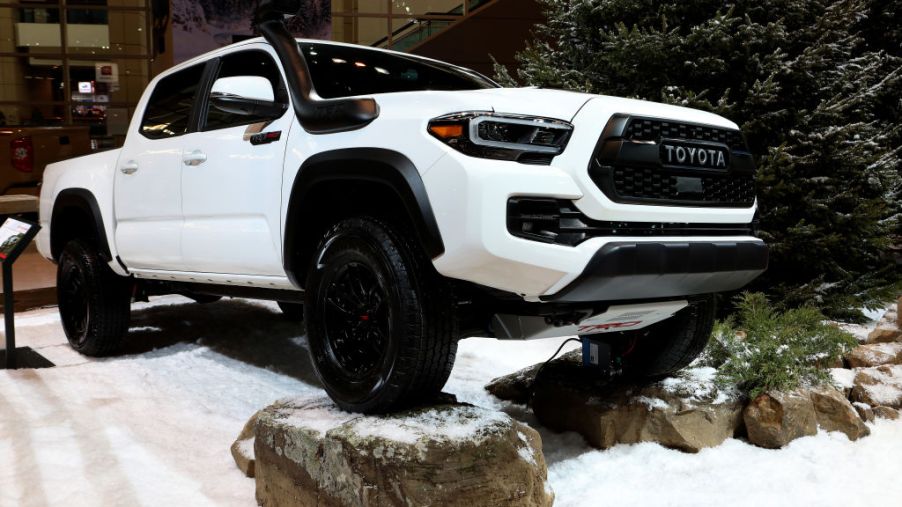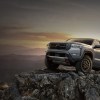
How Much Does the 2020 Toyota Tacoma Cost?
Larger pickups such as the Ford F-150 and the Dodge Ram 1500 have dominated the truck market for the past few years. But compact trucks offer great affordability and utility. And the trucks aren’t as small as the ’80s and ’90s vintage Ford Rangers or Nissan hardbodies were: most of these are closer in size to a midsize truck these days.
A compact truck that makes most of the top popular truck lists is the Toyota Tacoma. Ranked fifth in J.D. Power’s list of 10 most popular trucks, the Tacoma offers durability and off-road capability.
And, at first glance, this truck certainly seems affordable and offers solid value. But what do buyers get when they pony up $26,050 for the base model of the 2020 Toyota Tacoma? Will they need to pay a lot more for the features they most want? To find out, we’ll look at the features that come standard as well as those that don’t.
Standard Toyota Tacoma features
The base model four-seater Tacoma is no-frills, as U.S. News & World Report points out. Yet it’s slightly better than other equivalent trucks in its class because of Toyota’s reputation for building reliable vehicles that last.
Its 2.7-liter four-cylinder engine makes a paltry 159 hp and 180 lb-ft. The six-speed automatic transmission is lethargic. As a result, payload and towing capacity are middling at 1,685 pounds and 6,400 pounds, respectively. Rear-wheel drive is standard.
Inside, the Tacoma has cloth upholstery typically found in the lower-trim models of any Toyota. Four-way manually adjustable seats and an analog 4.2-inch gauge cluster display seem antiquated but is not out of the ordinary for a base-level truck.
The standard infotainment and tech features, updated for 2020, make this truck more appealing. These include Android Auto, Apple CarPlay, Amazon’s Alexa, satellite radio, Bluetooth tech, voice recognition. The hardware consists of a 7-inch touchscreen, three USB ports, and a six-speaker stereo system.
A wealth of standard safety features also helps the base Tacoma shine. In addition to a rearview camera, the truck has driver-assist tech such as lane departure warning, forward automatic emergency braking, pedestrian detection, automatic high-beam headlights, forward collision warning, and adaptive cruise control.
Features that cost (much) more
Buyers who aren’t satisfied with the base model’s limitations have big decisions ahead of them. They will need to sort through the Tacoma’s mind-boggling assortment of trim levels, options, and exterior packages. But they also need to know that upgrading will increase the sales price—sometimes significantly.
To move up to a more powerful V6 engine that delivers a robust 278 hp, buyers should look for a starting price of $28,310. The additional horsepower brings the towing capacity up to 6,800 pounds.
If drivers want more seating, expanding to a five-seat, double-cab configuration starts at $26,880. This configuration is better if adults are riding in the back seat, thanks to the expanded legroom of 32.5 inches. And with the double cab option, the size of the Tacoma’s truck bed increases from five feet to six.
Making it the off-road beast loved by enthusiasts will also cost more. The starting price for a four-wheel-drive model is $29,125.
To maximize the truck’s off-road performance, buyers should check out the TRD Off-Road model. Along with 4WD, it has off-road suspension, Bilstein shocks, and a locking rear differential. But at a starting price of $34,000, this model doesn’t come cheap.
Buyers with deep pockets can opt for the top-of-the-line TRD Pro that starts at $43,960. The king of the off-road Tacomas, the TRD Pro has a tuned suspension and exhaust, a front skid plate, Fox shocks, a multi-terrain monitor, LED fog lights, and fancier interior and exterior styling.
Is the 2020 Tacoma the right choice?
The Tacoma is a rugged, reliable compact truck that, like most Toyotas, holds a solid resale value. Even at the base level, it has an excellent safety package and up-to-date infotainment features. When equipped with four-wheel drive, it outshines its rivals.
But should buyers choose it over, say, the Ford Ranger or the Honda Ridgeline? U.S. News weighs in here and thinks that if they need utility and a stronger base engine, they should pick the Ranger. It has a 7,500-pound towing capacity and bests the Tacoma’s payload by almost 200 pounds.
U.S. News goes on to suggest that if utility isn’t as important to buyers but carlike handling is, the Ridgeline is a good option. The Ridgeline also offers as standard a roomier, more luxurious five-seat cab. Buyers can choose between front-wheel drive and all-wheel drive, as compared to the rear-wheel drive and four-wheel drive options common on other trucks.
And what about buyers who have their hearts set on a higher-trim Tacoma but don’t have the budget for it? They should shop for models made after 2016, which is when Toyota rolled the most recent generation of these trucks. If they are aware of the changes made since then, buyers can potentially save thousands of dollars on this popular truck.


